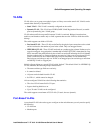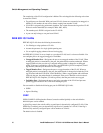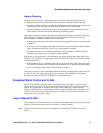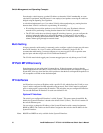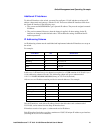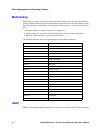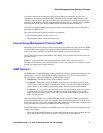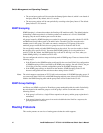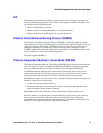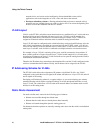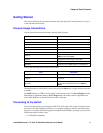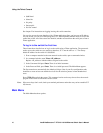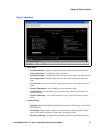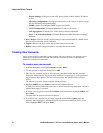Intel® NetStructure™ ZT 8101 10/100 Ethernet Switch User’s Manual 43
Switch Management and Operating Concepts
RIP
The Routing Information Protocol (RIP) is a distance-vector protocol that uses hop count as its
criteria for making routing decisions. The ZT 8101 switch supports both RIP v1 and RIP v2. You
can configure the following RIP options:
• Enable or disable RIP on the switch
• Enable or disable transmitting RIP packets on a specific IP interface
• Enable or disable receiving RIP packets on a specific IP interface
Distance Vector Multicast Routing Protocol (DVMRP)
The Distance Vector Multicast Routing Protocol (DVMRP) is a hop-based method of building
multicast delivery trees from multicast sources to all network nodes. Because the delivery trees are
“pruned” and use the “shortest path,” DVMRP is relatively efficient. Because multicast group
membership information is forwarded by a distance-vector algorithm, propagation is slow.
DVMRP is optimized for high delay (high latency) and relatively low bandwidth networks, and it
can be considered as a “best-effort” multicasting protocol.
The switch supports DVMRP v3.
Protocol-Independent Multicast - Dense Mode (PIM-DM)
The Protocol Independent Multicast - Dense Mode (PIM-DM) protocol should be used in networks
with a low delay (low latency) and high bandwidth because PIM-DM is optimized to guarantee
delivery of multicast packets, not to reduce overhead. The switch supports PIM-DM v2.
The PIM-DM multicast routing protocol assumes that all downstream routers want to receive
multicast messages and relies on explicit prune messages from downstream routers to remove
branches from the multicast delivery tree that do not contain multicast group members.
PIM-DM has no explicit “join” messages. It relies on periodic flooding of multicast messages to all
interfaces. It then waits for the following:
• A timer to expire (the join/prune interval)
• The downstream routers to transmit explicit “prune” messages indicating that there are no
multicast members on their respective branches.
PIM-DM then removes these branches (“prunes” them) from the multicast delivery tree.
Because a member of a pruned branch of a multicast delivery tree may want to join a multicast
delivery group (at some point in the future), the protocol periodically removes the prune
information from its database and floods multicast messages to all interfaces on that branch. The
interval for removing prune information is the join/prune interval.



